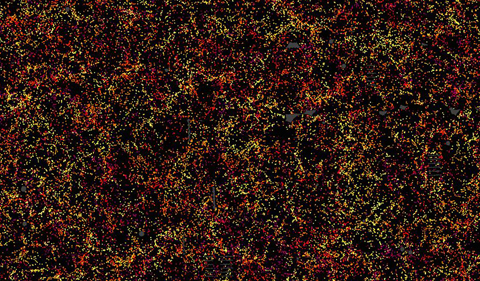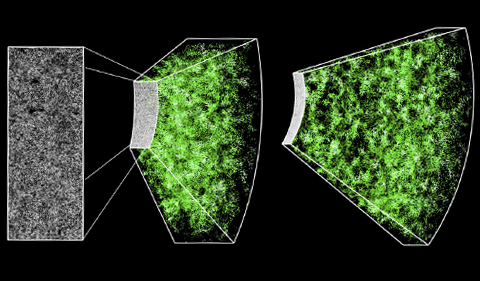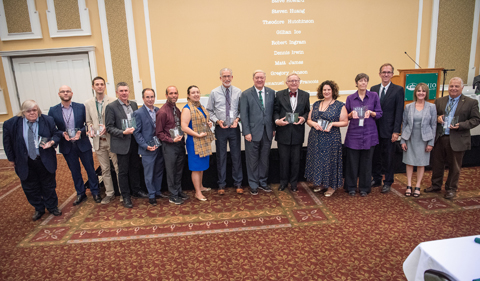
An international team of astronomers provides a slice through the map of the large-scale structure of the Universe. Each dot in this picture indicates the position of a galaxy 6 billion years into the past. Image credit: Daniel Eisenstein and SDSS-III.
The Astrophysical Research Consortium announced this week the sharpest results yet on the properties of dark energy. Hundreds of scientists from the Sloan Digital Sky Survey III (SDSS-III) collaborated to make the largest-ever, three-dimensional map of distant galaxies. The scientists then used this map to make one of the most precise measurements yet of the dark energy currently driving the accelerated expansion of the Universe.
Ohio University’s Dr. Hee-Jong Seo, Assistant Professor in Physics & Astronomy, and a member of the Astrophysical Institute, is a leading team member of two companion papers.

Dr. Hee-Jong Seo
These new measurements were carried out by the Baryon Oscillation Spectroscopic Survey (BOSS) program of SDSS-III, the massive spectroscopic surveys of the distant universe, the Milky Way Galaxy and extrasolar planetary systems.
“We have spent a decade collecting measurements of 1.2 million galaxies over one quarter of the sky to map out the structure of the universe over a volume of 650 cubic billion light years,” says Dr. Jeremy Tinker of New York University, a co-leader of the scientific team that led this effort. “This map has allowed us to make the best measurements yet of the effects of dark energy in the expansion of the universe. We are making our results and map available to the world.”
The map image provided by SDSS-III covers about 1/20th of the sky, a slice of the universe 6 billion light-years wide, 4.5 billion light-years high, and 500 million light-years thick. Color indicates distance from Earth, ranging from yellow on the near side of the slice to purple on the far side. Galaxies are highly clustered, revealing superclusters and voids whose presence is seeded in the first fraction of a second after the Big Bang. This image contains 48,741 galaxies, about 3 percent of the full survey dataset. Grey patches are small regions without survey data.
Shaped by a continuous tug-of-war between dark matter and dark energy, the map revealed by BOSS allows astronomers to measure the expansion rate of the universe and thus determine the amount of matter and dark energy that make up the present-day universe. A collection of papers describing these results was submitted this week to the Monthly Notices of the Royal Astronomical Society.
BOSS measures the expansion rate of the universe by determining the size of the baryonic acoustic oscillations (BAO) in the three-dimensional distribution of galaxies. The original BAO size is determined by pressure waves that traveled through the young universe up to when it was only 400,000 years old (the universe is presently 13.8 billion years old), at which point they became frozen in the matter distribution of the universe. The end result is that galaxies are preferentially separated by a characteristic distance, that astronomers call the acoustic scale. The size of the acoustic scale at 13.8 billion years ago has been exquisitely determined from observations of the cosmic microwave background from the light emitted when the pressure waves became frozen. Measuring the distribution of galaxies since that time allows astronomers to measure how dark matter and dark energy have competed to govern the rate of expansion of the universe.
“Measuring the acoustic scale across cosmic history gives a direct ruler with which to measure the Universe’s expansion rate. With BOSS, we have traced the BAO’s subtle imprint on the distribution of galaxies spanning a range of time from 2 to 7 billion years ago,” explains Dr. Ariel Sanchez of the Max-Planck Institute of Extraterrestrial Physics, who led the effort to estimate the exact amount of dark matter and dark energy based on the BOSS data.
“Imagine a 12-inch wooden ruler. When you place it further way, it would appear smaller. If you know the size of the ruler, and if you measure how small it appears, then you know the distance to it. This distance to cosmic time relationship tells us the Universe’s expansion rate. In this cosmological case, the ruler is the BAO and it is almost a half billion light years across. We need a huge survey volume to utilize this enormous ruler,” says Ohio University’s Seo.
Dr. Rita Tojeiro of the University of St. Andrews is the other co-leader of the BOSS galaxy clustering working group along with Tinker. “If we were to scale the volume of our survey to a cube 1 mile on each side, then the visible part of an individual galaxy would be about 1 millimeter across,” she explains. “Our challenge in the analysis of this map was equivalent to measuring the distances between all the pairs of galaxies separated by 100 yards throughout a cubic mile of space!”
To measure the size of these ancient giant waves to such sharp precision, BOSS had to make an unprecedented and ambitious galaxy map, many times larger than previous surveys. At the time the BOSS program was planned, dark energy had been previously determined to significantly influence the expansion of the universe starting about 5 billion years ago. BOSS was thus designed to measure the BAO feature from before this point (7 billion years ago) out to near the present day (2 billion years ago).

This is a section of the three-dimensional map constructed by BOSS. The rectangle on the far left shows a cutout of 1000 square degrees in the sky containing nearly 120,000 galaxies, or roughly 10 percent of the total survey. The spectroscopic measurements of each galaxy—every dot in that cutout—transform the two-dimensional picture into a three-dimensional map, extending our view out to 7 billion years in the past. The brighter regions in this map correspond to the regions of the Universe with more galaxies and therefore more dark matter. The extra matter in those regions creates an excess gravitational pull, which makes the map a test of Einstein’s theory of gravity. Image credit: Jeremy Tinker and SDSS-III.
“If dark energy has been driving the expansion of the Universe over that time, our maps tell us that it is evolving very slowly if at all: the change is at most 20% over the past 7 billion years,” says Dr. Florian Beutler of University of Portsmouth, who led two of the papers that were submitted this week.
Dr. Jose Vazquez of Brookhaven National Laboratory, who combined the BOSS results with other surveys and searched for evidence for any indication of unexplained physical phenomena in the results, says, “Our latest results tie into a clean cosmological picture, giving strength to the standard cosmological model that has emerged over the last 18 years.”
Tojeiro summarizes that “we see a dramatic connection between the sound wave imprints seen in the cosmic microwave background 400,000 years after the Big Bang to the clustering of galaxies 7-12 billion years later. The ability to observe a single well-modeled physical effect from recombination until today is a great boon for cosmology.”
The map also reveals the distinctive signature of the coherent movement of galaxies toward regions of the universe with more matter, due to the attractive force of gravity.
“We can test through this coherent motion if gravity is consistent with general relativity. If it is not, then this would be evidence that general relativity breaks down on cosmic scale, which could be the cause of the accelerated expansion,” OHIO’s Seo explains.
Crucially, the observed amount of infall is explained well by the predictions of general relativity. This agreement supports the idea that the acceleration of the expansion rate is driven by a phenomenon at the largest cosmic scales, such as dark energy, rather than a breakdown of our gravitational theory.
“BOSS has marked an important cosmological milestone,” Tinker concludes, “combining precise clustering measurements of an enormous volume with extensive observations of the primary cosmic microwave background to produce a firm platform for the search for extensions to the standard cosmological model. We look forward to seeing this program extended with the coming decade of large spectroscopic surveys.”
Funding for SDSS-III was provided by the Alfred P. Sloan Foundation, the Participating Institutions, the National Science Foundation, and the U.S. Department of Energy Office of Science.
SDSS-III is managed by the Astrophysical Research Consortium for the Participating Institutions of the SDSS‑III Collaboration including the University of Arizona, the Brazilian Participation Group, Brookhaven National Laboratory, Carnegie Mellon University, University of Florida, the French Participation Group, the German Participation Group, Harvard University, the Instituto de Astrofisica de Canarias, the Michigan State/Notre Dame/JINA Participation Group, Johns Hopkins University, Lawrence Berkeley National Laboratory, Max Planck Institute for Astrophysics, Max Planck Institute for Extraterrestrial Physics, New Mexico State University, New York University, Ohio State University, Pennsylvania State University, University of Portsmouth, Princeton University, the Spanish Participation Group, University of Tokyo, University of Utah, Vanderbilt University, University of Virginia, University of Washington, and Yale University.



















Comments